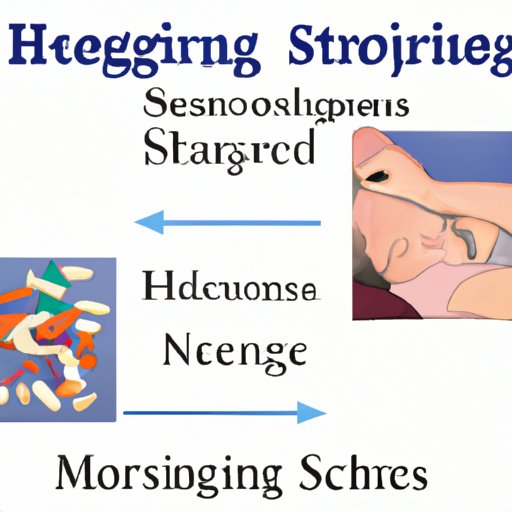
I. Introduction
Shingles is a painful and uncomfortable condition that many people experience in their lifetime. It is often caused by the reactivation of the varicella-zoster virus, which also causes chickenpox. If you have had chickenpox before, you are at risk of developing shingles later in life.
A. Definition of shingles and its symptoms
Shingles is a viral infection that affects the nerves and skin. The most common symptom is a painful rash that usually appears on one side of the body or face. Other symptoms can include itching, burning, and tingling sensations, as well as headache, fever, and fatigue.
B. Importance of understanding the duration of shingles
Knowing how long shingles will last can provide relief and comfort to those experiencing symptoms. It can also help people plan their time off work or commitments, and know when to seek medical attention if symptoms persist or worsen.
C. Brief summary of the topics that will be covered in the article
This article will explore how long you can expect to feel unwell with shingles, the stages and duration of the condition, factors that can affect the duration, the recovery process, coping strategies for fatigue and emotional toll, treatment options for complications, and tips for speeding up recovery.
II. The Duration of Shingles: How Long You Can Expect to Feel Unwell
The duration of shingles can vary from person to person, depending on several factors. Generally, shingles can last two to six weeks, with symptoms gradually decreasing over time. It’s important to understand the stages of shingles in order to determine how long your symptoms may last.
A. Explanation of the stages of shingles
Shingles typically goes through three stages:
- Stage 1: Prodromal stage – This is the initial stage where you may experience symptoms such as itching, burning, and tingling sensations. This can last for two to three days before the rash appears.
- Stage 2: Acute stage – This is when the rash appears and blisters start to form. This stage usually lasts two to three weeks.
- Stage 3: Healing stage – this stage is when the blisters start to dry up and heal. This stage can last one to two weeks.
B. The typical duration of each stage
As mentioned, the duration of each stage can vary from person to person. The prodromal stage can last two to three days, but for some people, it can last longer. The acute stage usually lasts two to three weeks, with the rash and blisters being the most painful and uncomfortable during this time. The healing stage can last one to two weeks, during which the blisters dry up and scab over before falling off.
C. Factors that can affect the duration of shingles
Several factors can impact how long shingles lasts, including age, overall health, and the location of the rash. Older adults or those with weakened immune systems may experience longer and more severe symptoms. The location of the rash, such as around the eyes or on the face, can also increase the risk of complications and prolong the duration of symptoms. Seeking medical attention and following treatment plans can help reduce the duration of shingles.
III. Why Shingles Takes So Long to Heal: Understanding the Recovery Process
Shingles can take a long time to heal due to the nature of the viral infection and the healing process. Understanding the process can help you take the necessary steps to speed up recovery.
A. The role of the immune system in fighting shingles
The immune system plays a critical role in fighting the varicella-zoster virus that causes shingles. The body’s immune response creates an inflammation response that leads to the development of painful blisters and rash. As the infection clears, the immune response lessens, allowing the body to heal.
B. Explanation of the healing process
The healing process for shingles involves the development of new skin cells to heal the rash and blisters. As the immune response subsides, scabs form, and the blisters start to dry up. The scabs eventually fall off, leaving new skin behind.
C. Factors that can slow down the healing process
Several factors can slow down the healing process, including age, overall health, and certain medications. People with weakened immune systems may take longer to heal, while some medications can interfere with the immune response and prolong symptoms.
IV. Coping with Shingles Fatigue: Tips for Boosting Energy and Reducing Discomfort
Shingles fatigue can be a common and challenging symptom to manage. Fortunately, several lifestyle changes and medical interventions can help reduce fatigue associated with shingles.
A. Common symptoms of shingles fatigue
Shingles fatigue is characterized by feelings of exhaustion and weakness, and it can make even minor tasks seem difficult. Other symptoms can include lack of energy, difficulty concentrating, and decreased appetite.
B. Lifestyle tips for managing fatigue
Several lifestyle changes can help alleviate shingles fatigue. These can include getting enough rest, engaging in gentle exercise, eating a healthy diet, and staying hydrated. Taking breaks throughout the day, prioritizing self-care, and avoiding stress can also be helpful.
C. Medical interventions for addressing fatigue
If lifestyle changes are not enough to manage shingles fatigue, medical interventions may be necessary. Medications such as antivirals or pain relievers can help reduce symptoms associated with shingles. It’s essential to speak with a healthcare provider about treatment options and address any concerns or side effects.

V. When Shingles Lasts Longer Than Expected: Identifying Complications and Seeking Treatment
In some cases, shingles can lead to further complications that require medical attention. Understanding these complications can help you identify potential issues and seek treatment when necessary.
A. Complications that can arise from shingles
Some complications of shingles may include vision loss if the rash appears around the eye, bacterial infection if the blisters become infected, and postherpetic neuralgia (PHN). PHN is the most common complication of shingles and is characterized by ongoing pain even after the rash has cleared.
B. Explanation of postherpetic neuralgia
PHN occurs when the nerves are damaged during the infection. Symptoms can include sharp and burning pain, itching, and sensitivity to touch. PHN can be a long-lasting and challenging symptom to manage.
C. Treatment options for complications
If you suspect you may be experiencing complications of shingles, it’s essential to seek medical attention. Treatment options may include medications to manage pain, antivirals to reduce inflammation, or medications to improve nerve function. It’s crucial to seek treatment early to reduce the risk of complications and improve the odds of a successful recovery.
VI. The Emotional Toll of Prolonged Shingles Symptoms: Strategies for Supporting Mental Health
Living with shingles can be challenging, both physically and mentally. Fortunately, several strategies can help support mental health and well-being during this time.
A. The emotional impact of shingles symptoms
The emotional impact of shingles can be significant and can lead to feelings of frustration, isolation, and even depression. Coping with ongoing symptoms can be challenging, particularly if they are prolonged or severe.
B. Self-care strategies to support mental health
Self-care strategies such as mindfulness meditation, exercise, and spending time outdoors can help support mental health during times of stress. It’s essential to prioritize self-care and take breaks as needed during the healing process.
C. Seeking help from mental health professionals
If you find that your symptoms are taking a significant emotional toll, it may be helpful to seek the help of a mental health professional. A counselor or therapist can help you work through any emotional challenges that arise and provide support and guidance during the recovery process.
VII. How to Shorten the Duration of Shingles: Lifestyle Tips and Medical Interventions to Speed Recovery
While there is no cure for shingles, several lifestyle changes and medical interventions can help speed up recovery and reduce symptoms.
A. Lifestyle changes that can help speed up recovery
Lifestyle changes such as good sleep hygiene, healthy eating, gentle exercise, stress reduction, and staying hydrated can help speed up the recovery process. Avoiding triggers such as alcohol, caffeine, and smoking can help reduce inflammation and promote healing.
B. Medical interventions for treating shingles
Antiviral medications can help reduce inflammation and speed up the healing process for shingles. Pain relievers may also be prescribed to manage symptoms such as pain. It’s important to speak with a healthcare provider about treatment options and address concerns or side effects promptly.
C. New treatments for shingles
New treatments for shingles are emerging, such as vaccines and immunotherapies. These treatments aim to prevent or reduce the severity and duration of shingles symptoms. It’s essential to stay informed about new treatment options and speak with a healthcare provider about any potential advantages and disadvantages.
VIII. Conclusion
Shingles can be a challenging and uncomfortable condition to manage. However, with the right knowledge and strategies, it’s possible to alleviate symptoms and speed up the recovery process. Understanding the duration of shingles, the recovery process, coping strategies for fatigue and emotional toll, and treatment options for complications can help you navigate and cope with this condition more effectively. If you have shingles, it’s essential to seek medical attention if necessary and prioritize self-care to support your physical and mental well-being.




